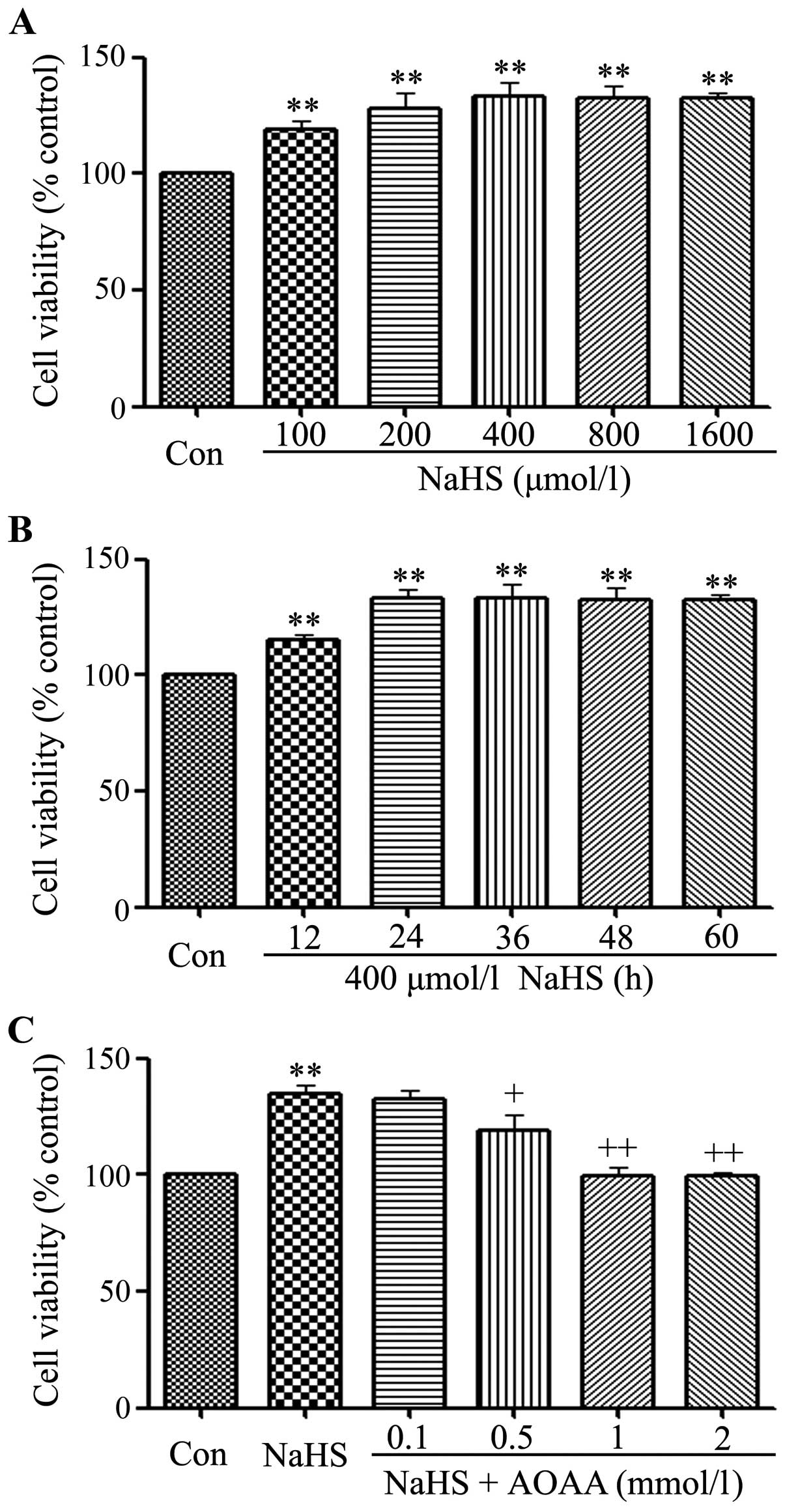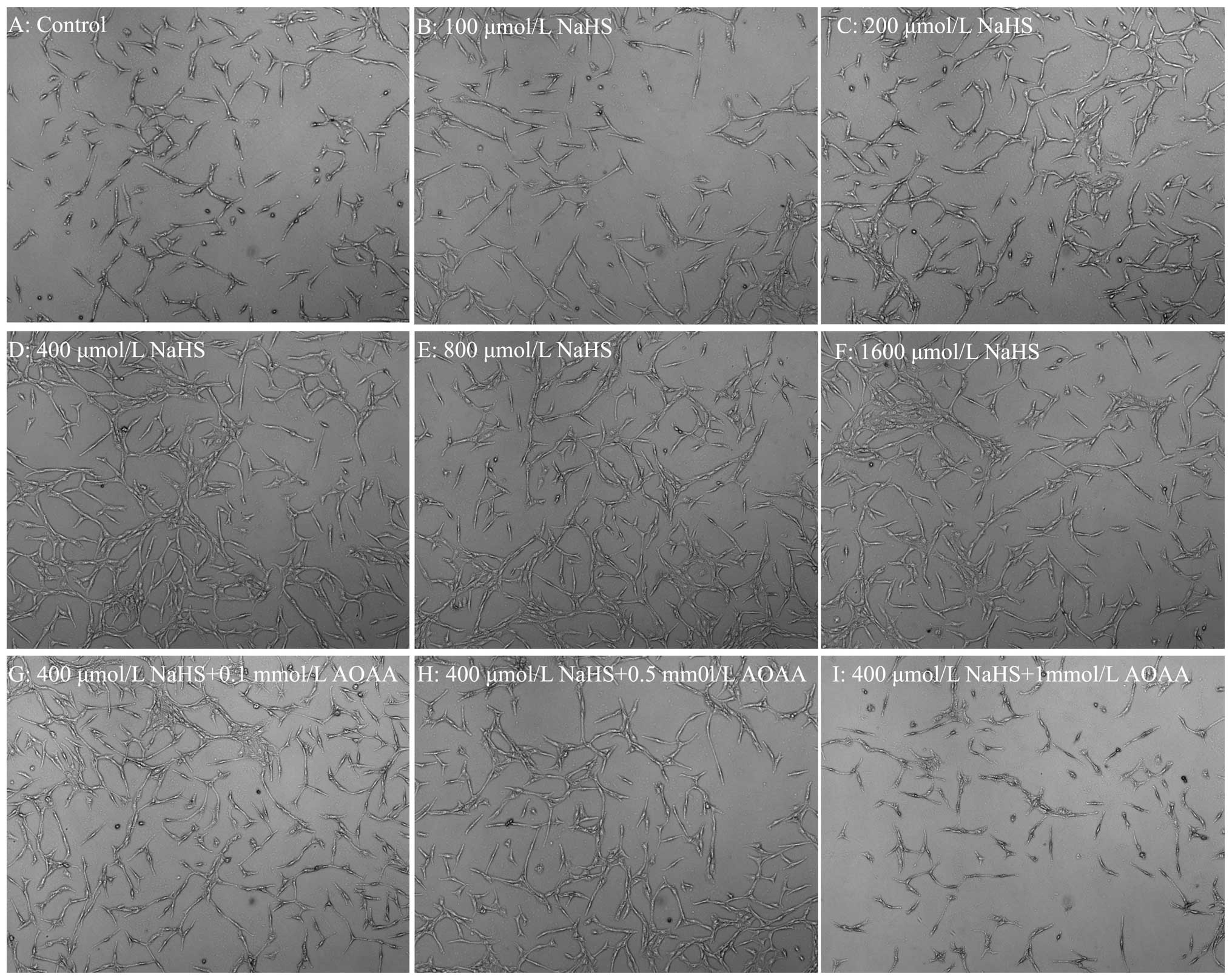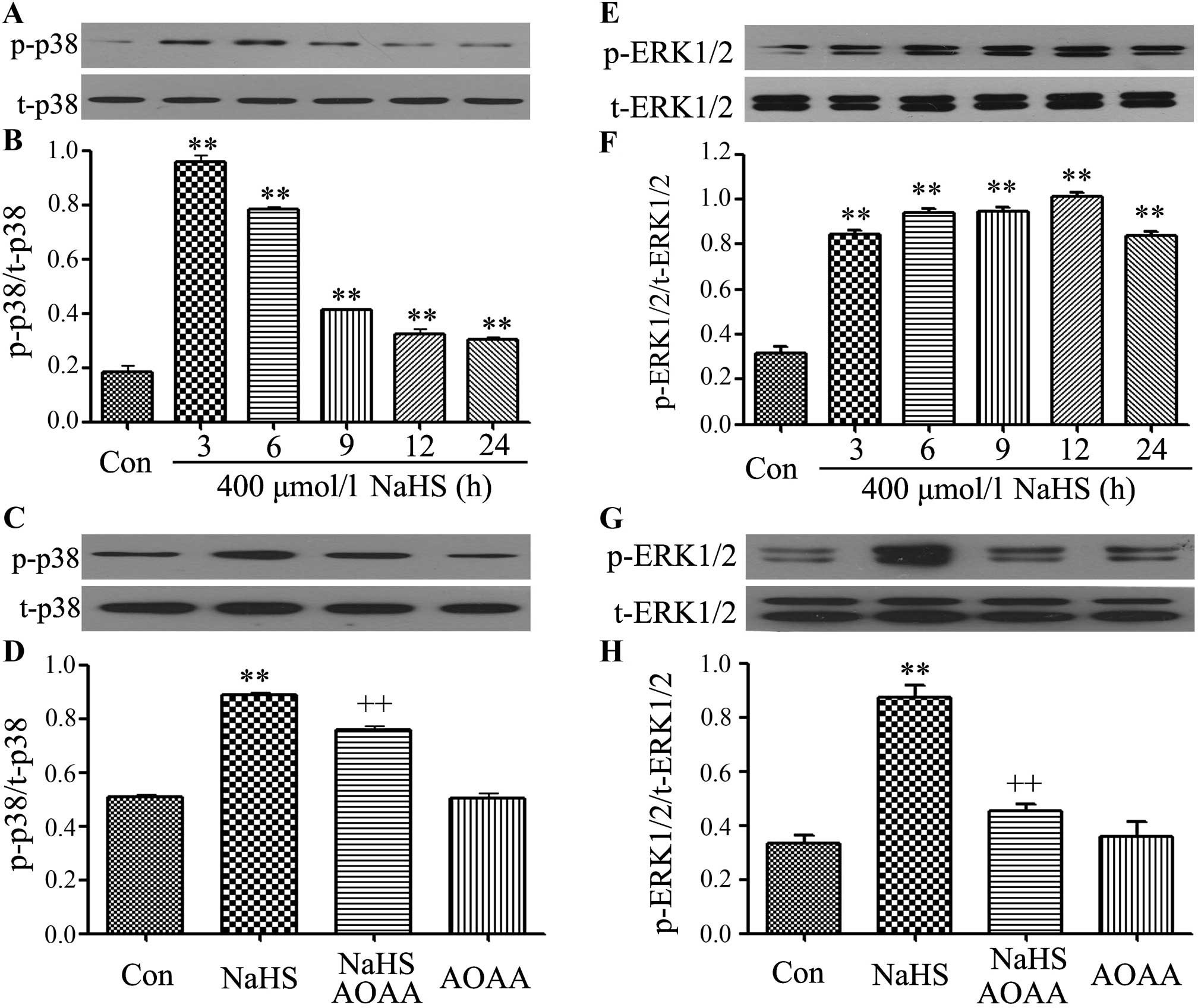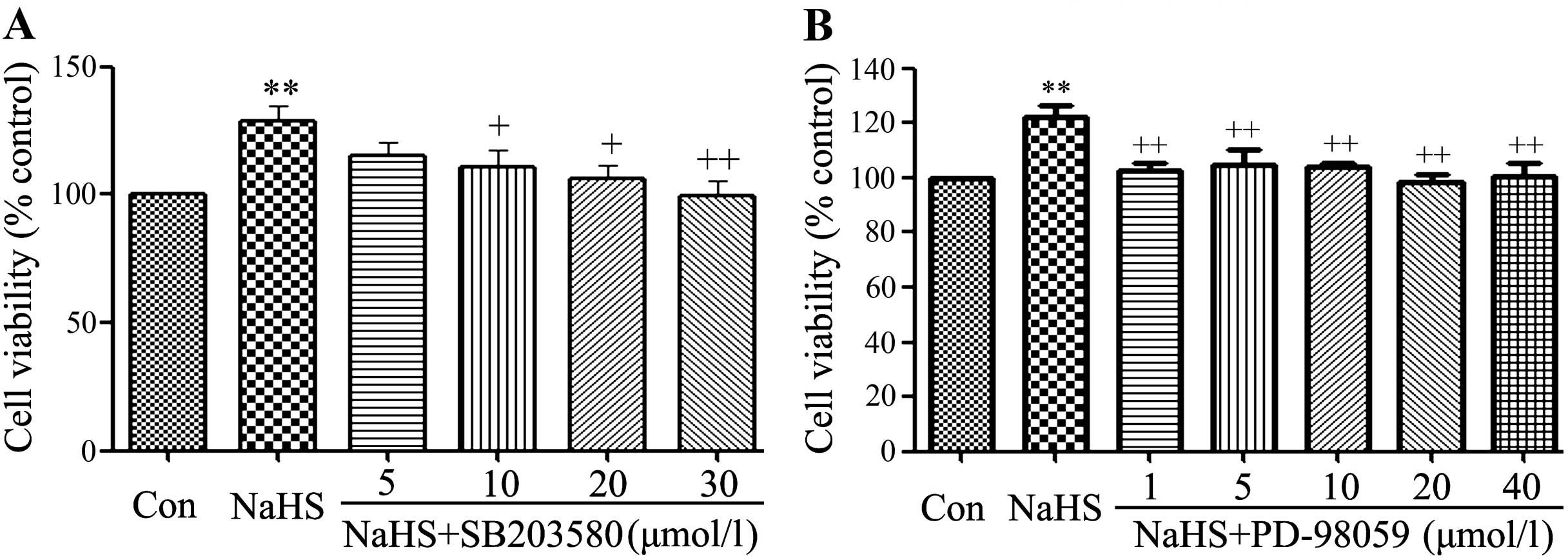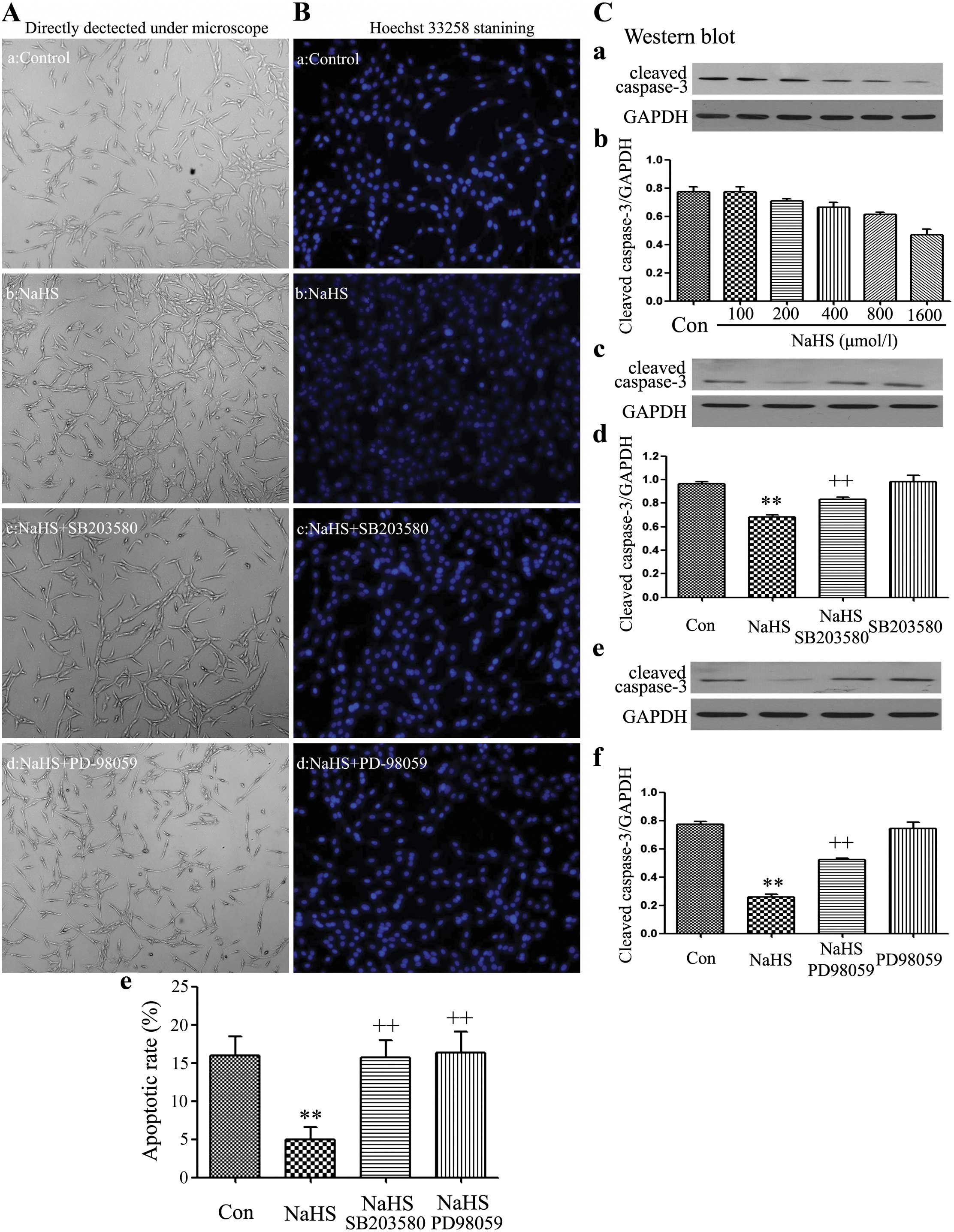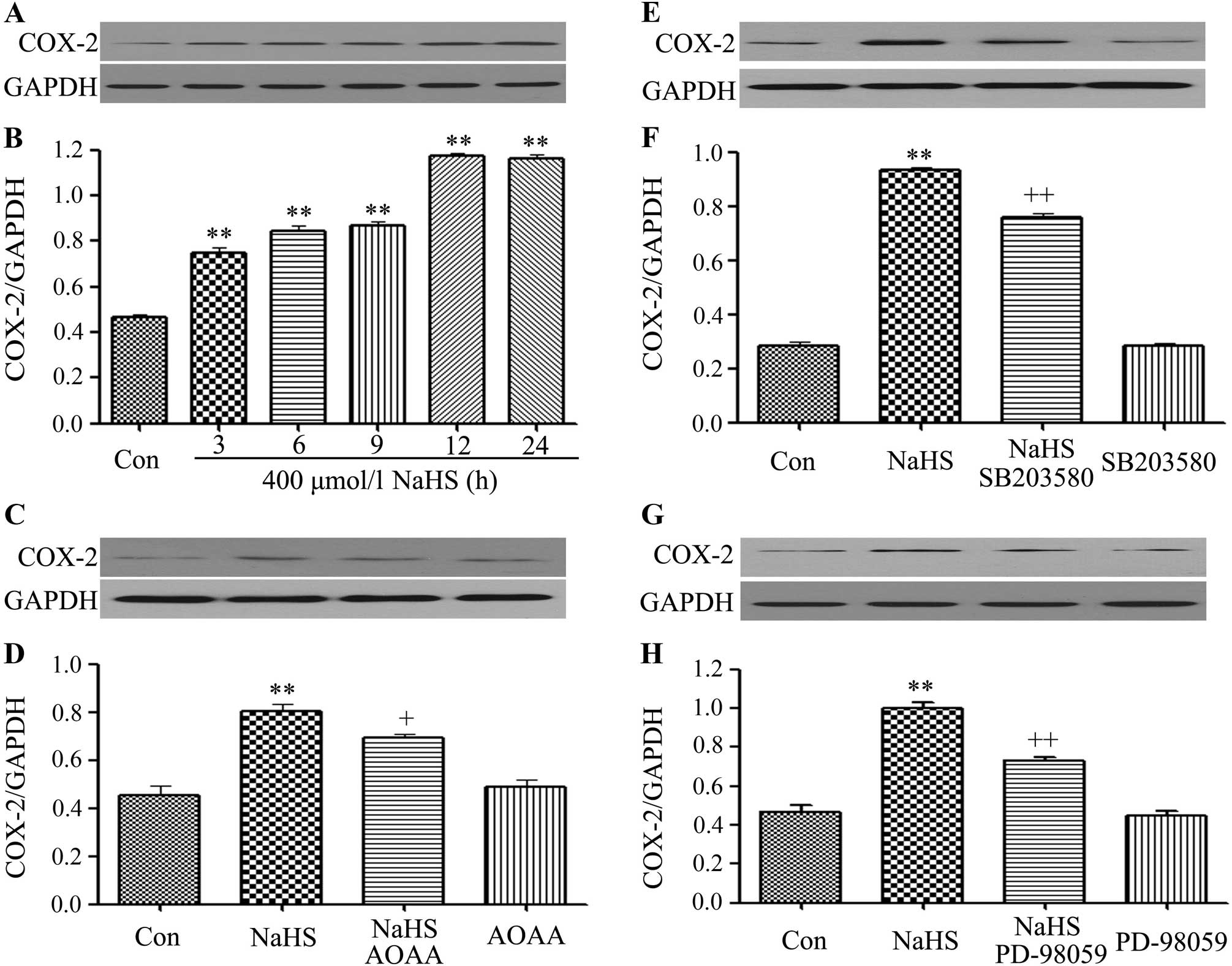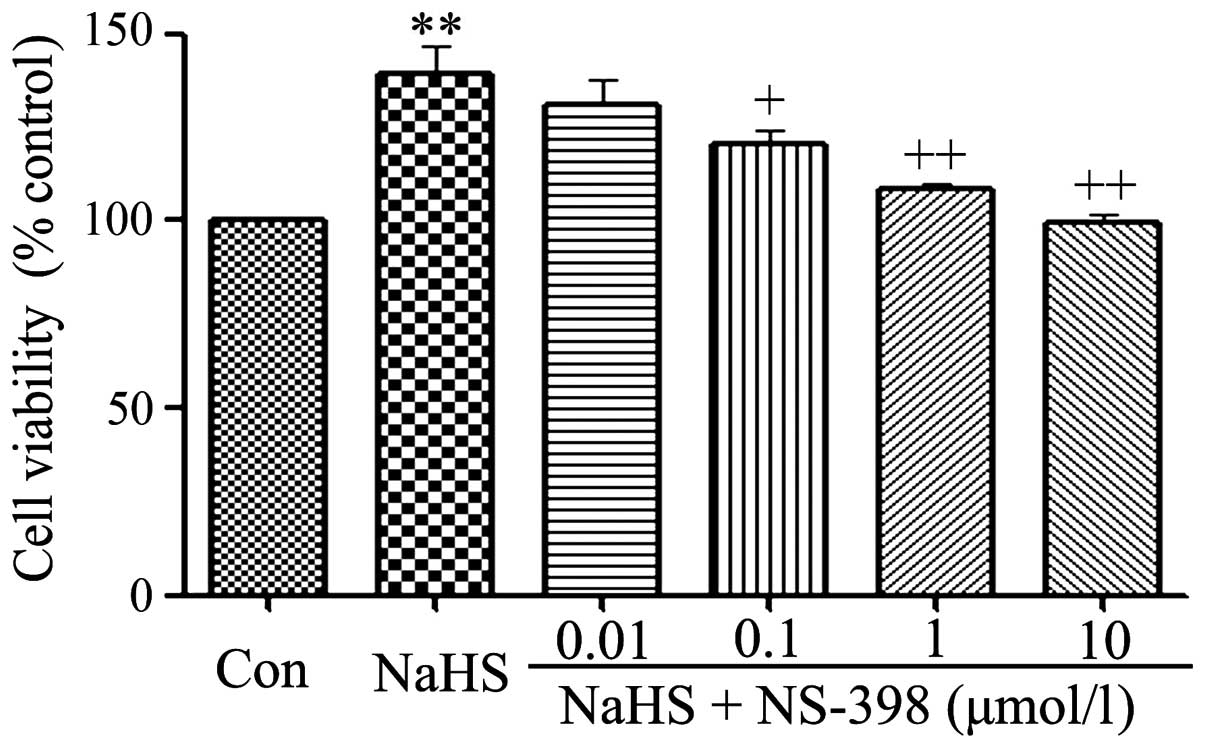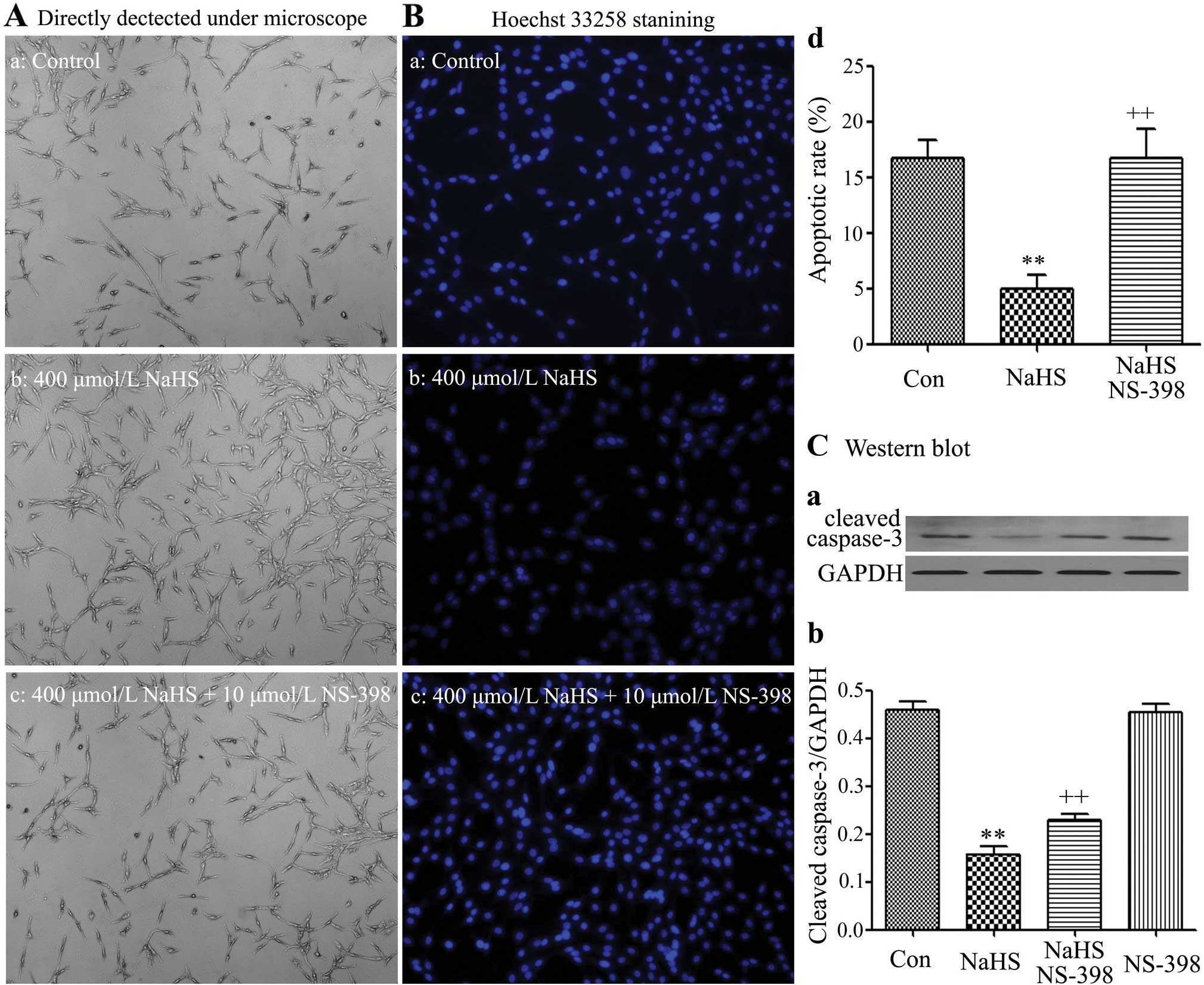Exogenous hydrogen sulfide promotes C6 glioma cell growth through activation of the p38 MAPK/ERK1/2-COX-2 pathways
- Authors:
- Published online on: September 8, 2015 https://doi.org/10.3892/or.2015.4248
- Pages: 2413-2422
Abstract
Introduction
Glioma is the most common malignant tumor and accounts for ~10% of tumors in the central nervous system (CNS) (1,2). Glioma accounts for 80% of malignant brain tumors (3). It is alarming that the prognosis of glioma, particularly high-grade (III–IV) glioma, is generally poor with standard chemotherapy and radiation therapy, and patients can only survive for an average of 1 year after diagnosis as a result of chemotherapy resistance (4). It is regrettable that the etiology of this disease still remains largely elusive. Elucidation of the molecular mechanisms of glioma is expected to lead to the identification of new therapeutic targets and to contribute to better clinical treatment and management of this devastating disease.
Mitogen-activated protein kinase (MAPK), which is a serine based protein kinase, and a highly conserved group of protein kinases that responds to miscellaneous changes of the cellular, intracellular or/and extracellular environment (DNA damage, hyperosmosis, oxidative stress, potentially harmful stimuli) (5–9), playing significant roles in signal transduction and taking part in a diverse range of physiological and pathological processes by modulating gene transcription in the nucleus, including cell proliferation, mitosis, differentiation, apoptosis, cell survival and gene expression (6). In mammals, MAPK consists of at least 11 members. The most studied MAPKs are the p38 MAPK, extracellular signal-regulated protein kinases 1/2 (ERK1/2) and c-Jun N-terminal kinases (JNK) (6). It has been reported that p38 MAPK and ERK1/2 pathways are important for glioma development (10–12). Previous studies have demonstrated that MAPKs (p38 MAPK and ERK1/2) also activate other signaling cascades, such as cyclooxygenase-2 (COX-2) (13,14), in a variety of cancer cell types. COX-2 expression is closely associated with tumor cell growth and is a crucial molecule in the development of malignant tumors, and angiogenesis (15,16), anti-apoptosis (17), invasiveness (18) and proliferation (19). In addition, a previous study demonstrated that COX-2 was activated dependent on the ERK1/2 pathway in glioma (20). However, evidence that the p38 MAPK/ERK1/2-mediated activation of the COX-2 pathway may be involved in growth of C6 glioma is lacking.
Hydrogen sulfide (H2S) has been qualified as the third gasotransmitter following nitric oxide (NO) and carbon monoxide (CO) (21–23). It can be endogenously produced mainly by cystathionine β-synthase (CBS) in the CNS. In recent years, more and more attention is paid to H2S for its extensive physiological and pathophysiological properties on cancer progresses. Some findings from in vivo and in vitro studies showed that H2S is beneficial for cancer cell growth, proliferation, migration and invasion (24–30), owing to its vascular relaxant and angiogenesis effects. H2S promotes the supply of nutrients and blood to the tumor cells and tissues (24). Our latest research also demonstrated that exogenous H2S promoted cancer cell proliferation/anti-apoptosis/angiogenesis/migration effects via amplifying the activation of NF-κB pathway (31). Furthermore, to the best of our knowledge, no study exists focused on the effect of exogenous H2S on C6 glioma cells and its potential mechanisms. Based on recent studies (24–31), we investigated whether exogenous H2S contributes to cancer progress and explored these potential effects via amplification of p38 MAPK/ERK1/2-COX-2 pathways in C6 glioma cells.
Materials and methods
Materials
NaHS, a donor of H2S, was obtained from Sigma Chemicals Co. (St. Louis, MO, USA), stored at 2–4°C and protected from sunlight. Hoechst 33258, AOAA (an inhibitor of CBS), SB203580 (an inhibitor of p38 MAPK), PD-98059 (an inhibitor of ERK1/2) and NS-398 (an inhibitor of COX-2) were also purchased from Sigma Chemicals Co. The Cell Counting Kit-8 (CCK-8) was supplied by Dojindo Laboratories (Kumamoto, Japan). Fetal bovine serum (FBS) and 1640 medium were obtained from Gibco-BRL (Grand Island, NY, USA). Anti-p38 MAPK, anti-ERK1/2, anti-p-p38 MAPK, anti-p-ERK1/2, anti-caspase-3 and anti-COX-2 antibodies were supplied by Cell Signaling Technology (Boston, MA, USA). Horseradish peroxidase (HRP)-conjugated secondary antibody and BCA protein assay kit were obtained from KangChen Biotech, Inc. (Shanghai, China). Enhanced chemiluminescence (ECL) solution was purchased from KeyGen Biotech.
Cell culture and treatments
The C6 glioma cells were supplied by Sun Yat-sen University Experimental Animal Center (Guangzhou, Guangdong, China). The cells were grown in 1640 medium supplemented with 10% FBS under an atmosphere of 5% CO2 and at 37°C with 95% air. The cells were treatment with 400 µmol/l NaHS for 24 h or co-treatment with 400 µmol/l NaHS and 30 µmol/l SB 203580 or 20 µmol/l PD-98059 or 10 µmol/l NS-398 for 24 h.
Hoechst 33258 nuclear staining for evaluation of apoptosis
Apoptotic cell death was tested by the Hoechst 33258 staining followed by photofluorography. Firstly, C6 glioma cells were plated in 35 mm dishes at a density of 1×106 cells/well. Following the above indicated treatments, the C6 glioma cells were fixed with 4% paraformaldehyde in 0.1 mol/l phosphate-buffered saline (PBS; pH 7.4) for 10 min at 4°C. Then, the slides were washed three times with PBS. After staining followed by 5 mg/ml Hoechst 33258 for 15 min, the PLC cells were washed three times with PBS. Lastly, the cells were visualized under a fluorescence microscope (B×50-FLA; Olympus, Tokyo, Japan). Viable C6 glioma cells displayed a uniform blue fluorescence throughout the nucleus and normal nuclear size. However apoptotic C6 glioma cells showed condensed, distorted or fractured nuclei. The experiment was carried out three times.
Western blot analysis
The cells were harvested and lysed with cell lysis solution at 4°C for 30 min. The total proteins were quantified through using the BCA protein assay kit. Loading buffer was added to cytosolic extracts, and then boiling for 6 min, the same amounts of supernatant from each sample were fractionated by 10% sodium dodecyl sulphate-polyacrylamide gel electrophoresis (SDS-PAGE), and the total proteins were transferred into polyvinylidene difluoride (PVDF) membranes. The membranes were blocked with 5% fat-free milk for 60 min in fresh blocking buffer [0.1% Tween-20 in Tris-buffered saline (TBS-T)] at room temperature, and incubated with either anti-p38 MAPK (1:1,000 dilution), anti-ERK1/2 (1:1,000 dilution), anti-p-p38 MAPK (1:1,000 dilution), anti-p-ERK1/2 (1:1,000 dilution), anti-caspase-3 (1:1,000 dilution) and anti-COX-2 antibodies (1:1,000 dilution) in freshly prepared TBS-T with 3% free-fat milk throughout the night with gentle agitation at 4°C. Membranes were washed for 5 min with TBS-T three times and incubated with HRP-conjugated goat anti-rabbit secondary antibody at a concentration of 1:3,000 dilution; (KangChen Biotech, Inc.), in TBS-T with 3% fat-free milk for 1.5 h at room temperature. Then membranes were washed three times with TBS-T for 5 min. The immunoreactive signals were visualized using the ECL detection. In order to quantify the protein expression, X-ray film was scanned and analyzed with ImageJ 1.47i software. The experiment was carried out three times.
Measurement of cell viability
The cells were seeded into 96-well plates at concentration of 1×104/ml, and were incubated at 37°C, the CCK-8 assay was employed to assess the cell viability of PLC cells. After the indicated treatments, 10 µl CCK-8 solution at a 1/10 dilution was added to each well and the plate was incubated for 1.5 h in the incubator. Absorbance at 450 nm was evaluated using a microplate reader (Molecular Devices, Sunnyvale, CA, USA). The means of the optical density (OD) of three wells in the indicated groups were used to calculate the percentage of cell viability according to the formula: Cell viability (%) = (OD treatment group/OD control group) × 100%. The experiment was carried out three times.
Cell proliferation
The cells were seeded into 24-well plates at concentration of 1×104/ml and were incubated at 37°C, After the indicated treatments, the cell number were directly detected under a fully automatic inverted microscope.
Statistical analysis
All data are presented as the mean ± SEM. Differences between groups were analyzed by one-way analysis of variance (ANOVA) using SPSS 13.0 (SPSS, Inc., Chicago, IL, USA) software, and followed by LSD post hoc comparison test. Statistical significance was considered as P<0.05.
Results
NaHS promotes cell proliferation in C6 glioma cells
In order to test the effect of exogenous H2S in C6 glioma cell viability, firstly, a dose-response study with varying doses (100, 200, 400, 800 and 1,600 µmol/l) of NaHS (a donor of H2S) for 24 h was performed to calculate the effective doses of NaHS. As shown in Fig. 1A, the doses of NaHS from 100 to 1,600 µmol/l markedly promoted cells proliferation, leading to an increase in cell viability and reaching a peaking at 400 µmol/l. Therefore, 400 µmol/l NaHS was used in the subsequent time-response study with different treatment times (12, 24, 36, 48 and 60 h). As shown in Fig. 1B, treatment of C6 glioma cells with 400 µmol/l NaHS for the indicated times all markedly promoted cells viability, reaching the maximal effect at 24 h. Based on the above results, C6 glioma cells were treated with 400 µmol/l NaHS for 24 h in all subsequent experiments.
Notably, the above increased cell viability was repressed by co-treatment with 400 µmol/l NaHS and different doses of AOAA (a specific inhibitor of CBS) for 24 h. As shown in Fig. 1C, at the doses of AOAA from 0.1 to 2 mmol/l significantly suppressed cell proliferation, leading to a decrease in cell viability and reaching the minimum at 1 mmol/l. According to the above results, C6 glioma cells were co-treated with 400 µmol/l NaHS and 2 mmol/l AOAA for 24 h in all the following experiment.
AOAA alleviates NaHS-induced cell proliferation in C6 glioma cells
As shown in Fig. 1, NaHS notably promotes cells proliferation in C6 glioma cells. In order to validate this phenomenon, the number of the cells was detected under the microscope. The cells were treated with different doses of NaHS (100, 200, 400, 800 and 1,600 µmol/l). As shown in Fig. 2, the doses of NaHS from 100 to 1,600 µmol/l markedly promoted cell proliferation, leading to an increase in cell number and reaching a peaking at 400 µmol/l. Thus, we showed that AOAA alleviates NaHS-induced increased cell proliferation in C6 glioma cells. As shown in Fig. 2G, H and I, at the doses of AOAA from 0.1 to 1 mmol/l significantly alleviated NaHS-induced increase of cell proliferation in C6 glioma cells, leading to a decrease in cell number and reaching the minimum at 1 mmol/l.
AOAA ameliorates the phosphorylation of p38 MAPK and ERK1/2 is induced by NaHS in C6 glioma cells
We observed the effects of NaHS on MAPK (including p38 MAPK and ERK1/2) phosphorylation. First, we further performed the time-study on the expression of p-p38 MAPK, after C6 glioma cells were exposed to 400 µmol/l NaHS for the indicated times (3, 6, 9, 12 and 24 h), the expression levels of p-p38 MAPK were significantly upregulated, reaching a peak at 3 h, and the t-p38 MAPK expression was unchanged.
Similarly, exposure of cells to 400 µmol/l NaHS also increased the expression levels of p-ERK1/2, as shown in the time-response study (Fig. 3E and F).
To observe effects of AOAA on the activation of MAPK induced by NaHS, C6 glioma cells were co-treated with 400 µmol/l NaHS and 2 mmol/l AOAA for 24 h. As shown in Fig. 3C, D, G and F, the increased phosphorylation of p38 MAPK and ERK1/2 was reduced.
SB203580 and PD98059 alleviates the NaHS-induced increase of cell viability in C6 glioma cells
As shown in Fig. 4, exposure of C6 glioma cells to 400 µmol/l NaHS for 24 h obviously induced cell proliferation, leading to an increase in cell viability. However, the increased cell viability was repressed by co-treatment with 400 µmol/l NaHS and different doses of SB203580 (a specific inhibitor of p38 MAPK pathway) or PD-98059 (a specific inhibitor of ERK1/2 pathway) for 24 h.
As shown in Fig. 4A, at 5 µmol/l SB203580 did not alter the cell viability. On the contrary, the dose of PDTC (10, 20 and 30 µmol/l) significantly suppressed the cell proliferation, leading to a decrease in cell viability and reaching the minimum at 30 µmol/l. According to the above results, C6 glioma cells were co-treated with 400 µmol/l NaHS and 30 µmol/l SB203580 for 24 h in all the following experiments.
Similarly, exposure of cells to 400 µmol/l NaHS and different doses of PD-98059 (1, 5, 10, 20 and 40 µmol/l) also suppressed cell proliferation, leading to a decrease in cell viability and reaching the minimum at 20 µmol/l, as shown in Fig. 4B. According to the above results, C6 glioma cells were co-treated with 400 µmol/l NaHS and 20 µmol/l PD-98059 for 24 h in all the following experiments.
SB203580 and PD98059 increase the NaHS-induced cell proliferation in C6 glioma cells
The cell number was detected using a fully automatic inverted microscope (Fig. 5-a–d). C6 glioma cells were co-treated with 400 µmol/l NaHS and 30 µmol/l SB203580 or 20 µmol/l PD-98059 for 24 h, respectively. As observed in Fig. 2, 400 µmol/l NaHS markedly promoted cells proliferation, leading to an increase in cell number. However, exposure of cells to 400 µmol/l NaHS and 30 µmol/l SB203580 or 20 µmol/l PD-98059 both significantly alleviated NaHS-induced cell proliferation in C6 glioma cells.
Apoptotic cell death was tested by Hoechst 33258 staining followed by photofluorography. As shown in the Fig. 5B-a–e, exposure of C6 glioma cells to 400 µmol/l NaHS for 24 h reduced the typical characteristics of apoptosis, as evidenced by the condensation of chromatin, the shrinkage of nuclei and the formation of apoptotic bodies. On the contrary, exposure of cells to 400 µmol/l NaHS and 30 µmol/l SB203580 or 20 µmol/l PD-98059 significantly induced the typical characteristics of apoptosis.
On the contrary, NaHS alone markedly upregulated the expression level of cleaved caspase-3. As illustrated in Fig. 5F and G, exposure of cells to indicated doses of NaHS (100, 200, 400, 800 and 1,600 µmol/l) for 24 h markedly downregulated the expression level of cleaved caspase-3. Whereas, exposure of cells to 400 µmol/l NaHS and 30 µmol/l SB203580 (Fig. 5C-c and -d) or 20 µmol/l PD-98059 (Fig. 5C-e and -f) significantly upregulated the expression level of cleaved caspase-3.
SB203580, PD98059 and AOAA inhibit the NaHS-induced increase of expression of COX-2 in C6 glioma cells
In order to observe the effects of NaHS on the expression levels of COX-2 and MMP-2 in C6 glioma cells, cells were exposured to 400 µmol/l NaHS for different times (3, 6, 9, 12 and 24 h). As shown in Fig. 6A and B, NaHS significantly enhanced the expression levels of COX-2 reaching a peak at 12 h. Notably, co-treatment of C6 glioma cells with 400 µmol/l NaHS and 30 µmol/l SB203580 (Fig. 6E and F) or 20 µmol/l PD-98059 (Fig. 6G and H) or 2 mmol/l AOAA (Fig. 6C and D) for 24 h considerably depressed the NaHS-induced increase of expression of COX-2. Treatment of cells with 30 µmol/l, SB203580 alone, or single treatment of 20 µmol/l PD-98059 or 2 mmol/l AOAA, respectively, for 24 h did not alter the basal expression level of COX-2.
NS-398 alleviates the NaHS-induced increase of cell viability in C6 glioma cells
As shown in Fig. 7, exposure of C6 glioma cells to 400 µmol/l NaHS for 24 h obviously induced cell proliferation, leading to an increase in cell viability. However, the increased cell viability was repressed by co-treatment with different doses of NS-398 (a specific inhibitor of COX-2 pathway) for 24 h.
As shown in Fig. 4, 0.01 µmol/l NS-398 did not alter cell viability. On the contrary, the dose of NS-398 from 0.1 to 10 µmol/l significantly suppressed the cell proliferation, leading to a decrease in cell viability and reaching the minimum at 10 µmol/l. According to the above results, C6 glioma cells were co-treated with 400 µmol/l NaHS and 10 µmol/l NS-398 for 24 h in the following experiments.
NS-398 increases the NaHS-induced cell proliferation in C6 glioma cells
Cell number was detected using a fully automatic inverted microscope (Fig. 5-a–d). C6 glioma cells were co-treated with 400 µmol/l NaHS and 10 µmol/l NS-398 for 24 h. As observed in Fig. 8A–b, alone 400 µmol/l NaHS markedly promoted cell proliferation, leading to an increase in the cell number. However, exposure of cells to 400 µmol/l NaHS and 10 µmol/l NS-398 significantly alleviated the NaHS-induced cell proliferation in C6 glioma cells.
Apoptotic cell death was evaluated by the Hoechst 33258 staining followed by photofluorography. As shown in the Fig. 8B-a–d, exposure of C6 glioma cells to 400 µmol/l NaHS for 24 h reduced the typical characteristics of apoptosis, as evidenced by the condensation of chromatin, the shrinkage of nuclei and the formation of apoptotic bodies. On the contrary, exposure of cells to 400 µmol/l NaHS and 10 µmol/l NS-398 significantly induced the typical characteristics of apoptosis.
On the contrary, NaHS alone markedly downregulated the expression level of cleaved caspase-3. As illustrated in Fig. 8C-a and -b, exposure of cells to 400 µmol/l NaHS for 24 h markedly downregulated the expression level of cleaved caspase-3. Whereas, exposure of cells to 400 µmol/l NaHS and 10 µmol/l NS-398 significantly upregulated the expression level of cleaved caspase-3.
Discussion
In the present study, we demonstrated a novel finding of tumor development by hydrogen sulfide (H2S) on C6 glioma cells and also provided data to revel its potential mechanisms. This conclusion is supported by several lines of evidence as follows: i) addition of NaHS (a donor of H2S; 100–1,600 µmol/l) promoted cell proliferation, leading to an increase in cell viability and an increase in cell number; ii) NaHS-induced a decrease in cell apoptosis, by decreasing expression level of caspase-3 and cell apoptosis; iii) AOAA inhibited the NaHS-induced proliferation and anti-apoptosis; iv) NaHS activated the p38 MAPK/ERK1/2 pathways and promoted the expression level of COX-2, and those effects were abolished by AOAA; v) SB203580 and PD98059 downregulated the NaHS-induced increased expression level of COX-2, respectively; vi) co-treatment of C6 glioma cells with NaHS SB203580, PD98059 or NS-398 suppressed the NaHS-induced proliferation and anti-apoptosis.
H2S is produced in the body mainly by three pyridoxal-59-phosphate-dependent enzymes, 3-mercaptopyruvate sulfurtransferase (3-MST), cystathionine-β-synthase (CBS) and cystathionine-γ-lyase (CSE). However, CBS is mainly found in the central nervous system (CNS) (32,33). A recent study suggested that H2S plays an important role in various physiological and pathological processes of the nervous system as a neuromodulator and neuroprotectant (34). Jiang et al found that H2S protected the brain against injuries and exerted neuroprotection by modulating the underlying signaling pathways (35–37). In addition, H2S exerted protection to nerve cancer cells, such as PC12 cells (38). It can be concluded that H2S may be involved in development of the nervous system cancer cells. In order to confirm this hypothesis, C6 glioma cells were exposed to NaHS (a donor of H2S). Unexpectedly, we found two interesting results. Firstly, different doses of NaHS (100–1,600 µmol/l) promoted cell proliferation in the range of physiological doses of H2S (0.2–1 mmol/l) the optimal concentration of NaHS that induced maximal effect of proliferation was 400 µmol/l, leading to an increase in cell viability and an increase in cell number. Secondly, treatment of cells with 400 µmol/l NaHS for 24 h markedly diminished cell apoptosis, and decreased the expression of caspase-3, one of the apoptotic factors, and the above NaHS-induced effects were inhibited by AOAA. These results demonstrate that H2S induces C6 glioma cell proliferation via exerting its dual cytoprotective and anti-apoptosis effects, and H2S may be involved in glioma growth under physiological conditions. Along with a previous study that H2S-protected PC12 cells from formaldehyde induced apoptosis (38), the results suggest that H2S exerts a cytoprotective effect for C6 glioma cells. The effects of H2S on cell proliferation and anti-apoptosis are complicated and unclear. In the present study, we investigated whether H2S promoted the proliferation ability and anti-apoptosis of C6 glioma cells in vitro by activation of the p38 MAPK/ERK1/2-COX-2 signaling pathways.
It has been reported that COX-2 pathway is closely associated with tumor cell growth and is a crucial molecule in the development of malignant tumors, and angiogenesis (15,16), anti-apoptosis (17), invasiveness (18) and proliferation (19). In the present study, we found that NS-398 (an inhibitor of COX-2) increased caspase-3 expression, which is consistent with previous research results (17,31). In addition, treatment of cells with 400 µmol/l NaHS for 24 h promoted the expression level of COX-2, along with the NaHS-induced pro-proliferative effect and anti-apoptosis. Combined treatment with a COX-2 inhibitor (NS-398) and 400 µmol/l NaHS resulted in a decrease in cell viability, a decrease in cell number, an increase in cell apoptosis and in increased expression level of cleaved caspase-3, indicating that NS-398 increases NaHS-induced cell proliferation in C6 glioma cells. Those results suggest that COX-2 pathway is necessary in NaHS-induced C6 glioma cell proliferation and anti-apoptosis.
The COX-2 pathway and its inhibitors are regulated by multiple signaling cascades, including the p38 signaling pathway as well as ERK1/2 and NF-κB-mediated pathways (15,20,31). To confirm whether NaHS-mediated activation of COX-2 was regulated by p38 MAPK or ERK1/2, C6 glioma cells were co-treated with 400 µmol/l NaHS and SB203580 (an inhibitor of p38 MAPK) or PD98059 (an inhibitor of ERK1/2), the expression level of COX-2 was downregulated. This result suggested that COX-2 was downstream of p38 MAPK or ERK1/2 pathways. In addition, treatment C6 glioma cells with 400 µmol/l NaHS activated p38 MAPK and ERK1/2 pathway, which is supported by NaHS-induced upregulation of p-p38 MAPK and ERK1/2 expression levels. Co-treatment of C6 glioma cells with NaHS and SB203580, PD98059 or NS-398 suppressed NaHS-induced proliferation and anti-apoptosis. Therefore, we concluded that p38 MAPK/ERK1/2-COX-2 pathways are involved in NaHS-induced cancer cell proliferation and anti-apoptotic in C6 glioma cells.
NaHS exert its proliferation and anti-apoptosis via activating p38 MAPK/ERK1/2-COX-2 pathways in C6 glioma cells, however, whether NaHS exerts its migration via activating p38 MAPK/ERK1/2-COX-2 pathways is still unclear, and needs further research in vivo and in vitro. The effects of H2S on the cancer are not completely coincident. Our research (31) and other studies (24–30) suggest that H2S is beneficial for cancer cells growth, proliferation, migration and invasion. On the contrary, some other researchers found that H2S exerted potential anticancer efficiency in SGC-7901 gastric cancer cells (40), oral cancer cell lines (41), colon cancer cells (42), and in several different human cancer cell lines (HeLa, HCT-116, Hep G2, HL-60, MCF-7, MV4-11 and U2OS) (43). As the above is contradictory further research must be carried out to clarify these issues.
In summary, H2S-induced cells proliferation and anti-apoptosis in C6 glioma cells. This effect may be mediated by the activation of p38 MAPK/ERK1/2-COX-2 pathways, leading to downregulation of caspase-3, increased cell viability, increased in cell number and decreased number of apoptotic cells. In C6 glioma, the findings provide a novel insight into a unified concept and identify CBS-derived H2S as an endogenous tumor-promoting factor and anticancer drug target. Furthermore, the migration and invasion of H2S in C6 glioma cells is still unclear and needs to be further investigated.
References
|
Louis DN, Ohgaki H, Wiestler OD, Cavenee WK, Burger PC, Jouvet A, Scheithauer BW and Kleihues P: The 2007 WHO classification of tumours of the central nervous system. Acta Neuropathol. 114:97–109. 2007. View Article : Google Scholar : PubMed/NCBI | |
|
Wei J, Gabrusiewicz K and Heimberger A: The controversial role of microglia in malignant gliomas. Clin Dev Immunol. 2013:2852462013. View Article : Google Scholar : PubMed/NCBI | |
|
Goodenberger ML and Jenkins RB: Genetics of adult glioma. Cancer Genet. 205:613–621. 2012. View Article : Google Scholar : PubMed/NCBI | |
|
Jansen M, Yip S and Louis DN: Molecular pathology in adult gliomas: Diagnostic, prognostic, and predictive markers. Lancet Neurol. 9:717–726. 2010. View Article : Google Scholar : PubMed/NCBI | |
|
Schaeffer HJ and Weber MJ: Mitogen-activated protein kinases: Specific messages from ubiquitous messengers. Mol Cell Biol. 19:2435–2444. 1999.PubMed/NCBI | |
|
Pearson G, Robinson F, Beers Gibson T, Xu BE, Karandikar M, Berman K and Cobb MH: Mitogen-activated protein (MAP) kinase pathways: Regulation and physiological functions. Endocr Rev. 22:153–183. 2001.PubMed/NCBI | |
|
Turjanski AG, Vaqué JP and Gutkind JS: MAP kinases and the control of nuclear events. Oncogene. 26:3240–3253. 2007. View Article : Google Scholar : PubMed/NCBI | |
|
Chang L and Karin M: Mammalian MAP kinase signalling cascades. Nature. 410:37–40. 2001. View Article : Google Scholar : PubMed/NCBI | |
|
Roux PP and Blenis J: ERK and p38 MAPK-activated protein kinases: A family of protein kinases with diverse biological functions. Microbiol Mol Biol Rev. 68:320–344. 2004. View Article : Google Scholar : PubMed/NCBI | |
|
Ding D, Wei S, Song Y, Li L, Du G, Zhan H and Cao Y: Osthole exhibits anti-cancer property in rat glioma cells through inhibiting PI3K/Akt and MAPK signaling pathways. Cell Physiol Biochem. 32:1751–1760. 2013. View Article : Google Scholar : PubMed/NCBI | |
|
Zhang B, Wu T, Wang Z, Zhang Y, Wang J, Yang B, Zhao Y, Rao Z and Gao J: p38MAPK activation mediates tumor necrosis factor-α-induced apoptosis in glioma cells. Mol Med Rep. 11:3101–3107. 2015. | |
|
Li F, Chen T, Hu S, Lin J, Hu R and Feng H: Superoxide mediates direct current electric field-induced directional migration of glioma cells through the activation of AKT and ERK. PLoS One. 8:e611952013. View Article : Google Scholar : PubMed/NCBI | |
|
Subbaramaiah K, Chung WJ and Dannenberg AJ: Ceramide regulates the transcription of cyclooxygenase-2. Evidence for involvement of extracellular signal-regulated kinase/c-Jun N-terminal kinase and p38 mitogen-activated protein kinase pathways. J Biol Chem. 273:32943–32949. 1998. View Article : Google Scholar : PubMed/NCBI | |
|
Limami Y, Pinon A, Leger DY, Pinault E, Delage C, Beneytout JL, Simon A and Liagre B: The P2Y2/Src/p38/COX-2 pathway is involved in the resistance to ursolic acid-induced apoptosis in colorectal and prostate cancer cells. Biochimie. 94:1754–1763. 2012. View Article : Google Scholar : PubMed/NCBI | |
|
Kim JY, Chung SW, Kim SY and Byun Y: Enhanced anti-angiogenic effect of low molecular weight heparinbile acid conjugates by co-administration of a selective COX-2 inhibitor. Pharm Res. 32:2318–2327. 2015. View Article : Google Scholar : PubMed/NCBI | |
|
Tegeder I, Niederberger E, Israr E, Gühring H, Brune K, Euchenhofer C, Grösch S and Geisslinger G: Inhibition of NF-kappaB and AP-1 activation by R- and S-flurbiprofen. FASEB J. 15:2–4. 2001. | |
|
Seo KW, Coh YR, Rebhun RB, Ahn JO, Han SM, Lee HW and Youn HY: Antitumor effects of celecoxib in COX-2 expressing and non-expressing canine melanoma cell lines. Res Vet Sci. 96:482–486. 2014. View Article : Google Scholar : PubMed/NCBI | |
|
Wu X, Cai M, Ji F and Lou LM: The impact of COX-2 on invasion of osteosarcoma cell and its mechanism of regulation. Cancer Cell Int. 14:272014. View Article : Google Scholar : PubMed/NCBI | |
|
Wu T, Han C, Lunz JG III, Michalopoulos G, Shelhamer JH and Demetris AJ: Involvement of 85-kd cytosolic phospholipase A and cyclooxygenase-2 in the proliferation of human cholangio-2 carcinoma cells. Hepatology. 36:363–373. 2002. View Article : Google Scholar : PubMed/NCBI | |
|
Chiu WT, Shen SC, Chow JM, Lin CW, Shia LT and Chen YC: Contribution of reactive oxygen species to migration/invasion of human glioblastoma cells U87 via ERK-dependent COX-2/PGE2 activation. Neurobiol Dis. 37:118–129. 2010. View Article : Google Scholar | |
|
Wang R: Two's company, three's a crowd: Can H2S be the third endogenous gaseous transmitter? FASEB J. 16:1792–1798. 2002. View Article : Google Scholar : PubMed/NCBI | |
|
Guidotti TL: Hydrogen sulfide: Advances in understanding human toxicity. Int J Toxicol. 29:569–581. 2010. View Article : Google Scholar : PubMed/NCBI | |
|
Kilburn KH, Thrasher JD and Gray MR: Low-level hydrogen sulfide and central nervous system dysfunction. Toxicol Ind Health. 26:387–405. 2010. View Article : Google Scholar : PubMed/NCBI | |
|
Szabo C, Coletta C, Chao C, Módis K, Szczesny B, Papapetropoulos A and Hellmich MR: Tumor-derived hydrogen sulfide, produced by cystathionine-β-synthase, stimulates bioenergetics, cell proliferation, and angiogenesis in colon cancer. Proc Natl Acad Sci USA. 110:12474–12479. 2013. View Article : Google Scholar | |
|
Pupo E, Pla AF, Avanzato D, Moccia F, Cruz JE, Tanzi F, Merlino A, Mancardi D and Munaron L: Hydrogen sulfide promotes calcium signals and migration in tumor-derived endothelial cells. Free Radic Biol Med. 51:1765–1773. 2011. View Article : Google Scholar : PubMed/NCBI | |
|
Du SX, Xiao J, Guan F, Sun LM, Wu WS, Tang H, Du JB, Tang CS and Jin HF: Predictive role of cerebrospinal fluid hydrogen sulfide in central nervous system leukemia. Chin Med J. 124:3450–3454. 2011. | |
|
Levine J, Ellis CJ, Furne JK, Springfield J and Levitt MD: Fecal hydrogen sulfide production in ulcerative colitis. Am J Gastroenterol. 93:83–87. 1998. View Article : Google Scholar : PubMed/NCBI | |
|
Rose P, Moore PK, Ming SH, Nam OC, Armstrong JS and Whiteman M: Hydrogen sulfide protects colon cancer cells from chemopreventative agent beta-phenylethyl isothiocyanate induced apoptosis. World J Gastroenterol. 11:3990–3997. 2005.PubMed/NCBI | |
|
Cai WJ, Wang MJ, Ju LH, Wang C and Zhu YC: Hydrogen sulfide induces human colon cancer cell proliferation: Role of Akt, ERK and p21. Cell Biol Int. 34:565–572. 2010. View Article : Google Scholar : PubMed/NCBI | |
|
Cao Q, Zhang L, Yang G, Xu C and Wang R: Butyrate-stimulated H2S production in colon cancer cells. Antioxid Redox Signal. 12:1101–1109. 2010. View Article : Google Scholar | |
|
Zhen Y, Pan W, Hu F, Wu H, Feng J, Zhang Y and Chen J: Exogenous hydrogen sulfide exerts proliferation/anti-apoptosis/angiogenesis/migration effects via amplifying the activation of NF-κB pathway in PLC/PRF/5 hepatoma cells. Int J Oncol. 46:2194–2204. 2015.PubMed/NCBI | |
|
Tan BH, Wong PT and Bian JS: Hydrogen sulfide: A novel signaling molecule in the central nervous system. Neurochem Int. 56:3–10. 2010. View Article : Google Scholar | |
|
Rong W, Kimura H and Grundy D: The neurophysiology of hydrogen sulfide. Inflamm Allergy Drug Targets. 10:109–117. 2011. View Article : Google Scholar : PubMed/NCBI | |
|
Zhang X and Bian JS: Hydrogen sulfide: A neuromodulator and neuroprotectant in the central nervous system. ACS Chem Neurosci. 5:876–883. 2014. View Article : Google Scholar : PubMed/NCBI | |
|
Chan SJ, Chai C, Lim TW, Yamamoto M, Lo EH, Lai MK and Wong PT: Cystathionine β-synthase inhibition is a potential therapeutic approach to treatment of ischemic injury. ASN Neuro. 7:17590914155787112015. View Article : Google Scholar | |
|
Chen WL, Niu YY, Jiang WZ, Tang HL, Zhang C, Xia QM and Tang XQ: Neuroprotective effects of hydrogen sulfide and the underlying signaling pathways. Rev Neurosci. 26:129–142. 2015. View Article : Google Scholar | |
|
Donatti AF, Soriano RN, Sabino JP and Branco LG: Involvement of endogenous hydrogen sulfide (H2S) in the rostral ventrolateral medulla (RVLM) in hypoxia-induced hypothermia. Brain Res Bull. 108:94–99. 2014. View Article : Google Scholar : PubMed/NCBI | |
|
Jiang JM, Zhou CF, Gao SL, Tian Y, Wang CY, Wang L, Gu HF and Tang XQ: BDNF-TrkB pathway mediates neuroprotection of hydrogen sulfide against formaldehyde-induced toxicity to PC12 cells. PLoS One. 10:e01194782015. View Article : Google Scholar : PubMed/NCBI | |
|
Xu K, Wang L and Shu HK: COX-2 overexpression increases malignant potential of human glioma cells through Id1. Oncotarget. 5:1241–1252. 2014. View Article : Google Scholar : PubMed/NCBI | |
|
Ma K, Liu Y, Zhu Q, Liu CH, Duan JL, Tan BK and Zhu YZ: H2S donor, S-propargylcysteine, increases CSE in SGC-7901 and cancer-induced mice: Evidence for a novel anti-cancer effect of endogenous H2S? PLoS One. 6:e205252011. View Article : Google Scholar | |
|
Murata T, Sato T, Kamoda T, Moriyama H, Kumazawa Y and Hanada N: Differential susceptibility to hydrogen sulfide-induced apoptosis between PHLDA1-overexpressing oral cancer cell lines and oral keratinocytes: Role of PHLDA1 as an apoptosis suppressor. Exp Cell Res. 320:247–257. 2014. View Article : Google Scholar | |
|
Chattopadhyay M, Kodela R, Olson KR and Kashfi K: NOSH-aspirin (NBS-1120), a novel nitric oxide- and hydrogen sulfide-releasing hybrid is a potent inhibitor of colon cancer cell growth in vitro and in a xenograft mouse model. Biochem Biophys Res Commun. 419:523–528. 2012. View Article : Google Scholar : PubMed/NCBI | |
|
Lee ZW, Zhou J, Chen CS, Zhao Y, Tan CH, Li L, Moore PK and Deng LW: The slow-releasing hydrogen sulfide donor, GYY4137, exhibits novel anti-cancer effects in vitro and in vivo. PLoS One. 6:e210772011. View Article : Google Scholar : PubMed/NCBI |



